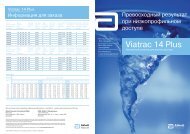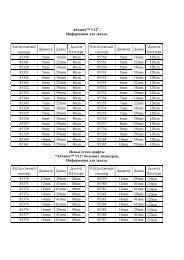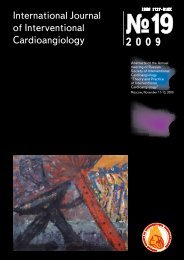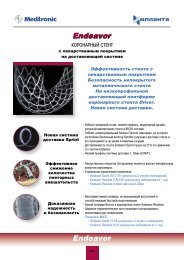Results of Coronary Stenting using the Stents with
Results of Coronary Stenting using the Stents with
Results of Coronary Stenting using the Stents with
You also want an ePaper? Increase the reach of your titles
YUMPU automatically turns print PDFs into web optimized ePapers that Google loves.
Interventional cardiology<br />
reveal statistically reliable relation between any factor<br />
and <strong>the</strong> development <strong>of</strong> <strong>the</strong>se complications.<br />
The analysis <strong>of</strong> <strong>the</strong> influence <strong>of</strong> <strong>the</strong> stent length<br />
on <strong>the</strong> frequency <strong>of</strong> restenosis revealed statistically<br />
significant differences in Group2: <strong>the</strong> implantation<br />
<strong>of</strong> stents longer than 23 mm was related to higher<br />
frequency <strong>of</strong> restenosis in comparison <strong>with</strong> shorter<br />
stents (р0.05).<br />
The study <strong>of</strong> <strong>the</strong> influence <strong>of</strong> stent’s diameter and<br />
length on <strong>the</strong> development <strong>of</strong> late stent thrombosis<br />
has shown that in all three cases <strong>of</strong> stent thrombosis<br />
in <strong>the</strong> control group <strong>the</strong> diameter <strong>of</strong> endopros<strong>the</strong>sis<br />
was < 2,75 mm, while its length was > 18 mm .<br />
After stenting all patients received double antiplatelet<br />
<strong>the</strong>rapy. The Table № 6 shows different<br />
regimens <strong>of</strong> antiplatelet <strong>the</strong>rapy in <strong>the</strong> mid-term<br />
follow-up.<br />
The Table shows that <strong>the</strong> number <strong>of</strong> patients receiving<br />
double atniplatelet <strong>the</strong>rapy in <strong>the</strong> mid-term<br />
follow-up was not statistically significant between <strong>the</strong><br />
studied groups. A patient from Group 2 <strong>with</strong> subacute<br />
stent thrombosis received Plavix (75 mg/day) by <strong>the</strong><br />
moment <strong>of</strong> thrombus formation. One <strong>of</strong> two patients<br />
<strong>with</strong> late thrombosis has stopped to take Plavix in 4<br />
months after <strong>the</strong> implantation <strong>of</strong> Cypher. Ano<strong>the</strong>r patient<br />
received Plavix (75 mg/day) by <strong>the</strong> moment <strong>of</strong><br />
late stent thrombosis development.<br />
Thus, <strong>the</strong> comparison <strong>of</strong> <strong>the</strong> results revealed that<br />
in <strong>the</strong> mid-term follow-up <strong>the</strong> rate <strong>of</strong> restenosis was<br />
somewhat higher in <strong>the</strong> group <strong>of</strong> stents <strong>with</strong> permanent<br />
polymer coating. However this difference between<br />
<strong>the</strong> groups was statistically insignificant.<br />
The analysis <strong>of</strong> <strong>the</strong> obtained results did not reveal<br />
any correlation between <strong>the</strong> rates <strong>of</strong> restenosis, progressing<br />
<strong>of</strong> a<strong>the</strong>rosclerotic process and any clinical<br />
risk factor in <strong>the</strong> studied groups.<br />
The analysis <strong>of</strong> <strong>the</strong> influence <strong>of</strong> <strong>the</strong> stent’s diameter<br />
and length has shown that in Group 2 patients<br />
<strong>the</strong> rate <strong>of</strong> thrombosis was significantly higher in <strong>the</strong><br />
presence <strong>of</strong> stents longer than 18 mm in comparison<br />
<strong>with</strong> Group1.<br />
Total rate <strong>of</strong> thrombosis was statistically different<br />
between <strong>the</strong> groups (p0.05<br />
Late — 3 (2,4%) < 0.05<br />
Thromboses, in total — 4 (3,2%) < 0.05<br />
р>0,05 non-significant differences; n – number <strong>of</strong> stents<br />
Antiplatelet <strong>the</strong>rapy in <strong>the</strong> studied groups in different periods <strong>of</strong> follow-up<br />
Table № 6.<br />
Antiplatelet<br />
regimen<br />
Up to 3 months 3 – 6 months 6 – 9 months > 9 months<br />
Gr.1 Gr.2 Р Gr.1 Gr.2 Р Gr.1 Gr.2 р Gr.1 Gr.2 р<br />
Plavix + Aspirin 51 66 р>0,05 49 63 р>0,05 45 57 р>0,05 38 49 р>0,05<br />
Only Plavix — — — — — — — — —<br />
Only Aspirin — — 2 3 р>0,05 4 6 р>0,05 10 13 р>0,05<br />
No antiplatelet<br />
<strong>the</strong>rapy<br />
— — — — — 2 3 р>0,05 3 4 р>0,05<br />
20<br />
(№ 26, 2011)
















